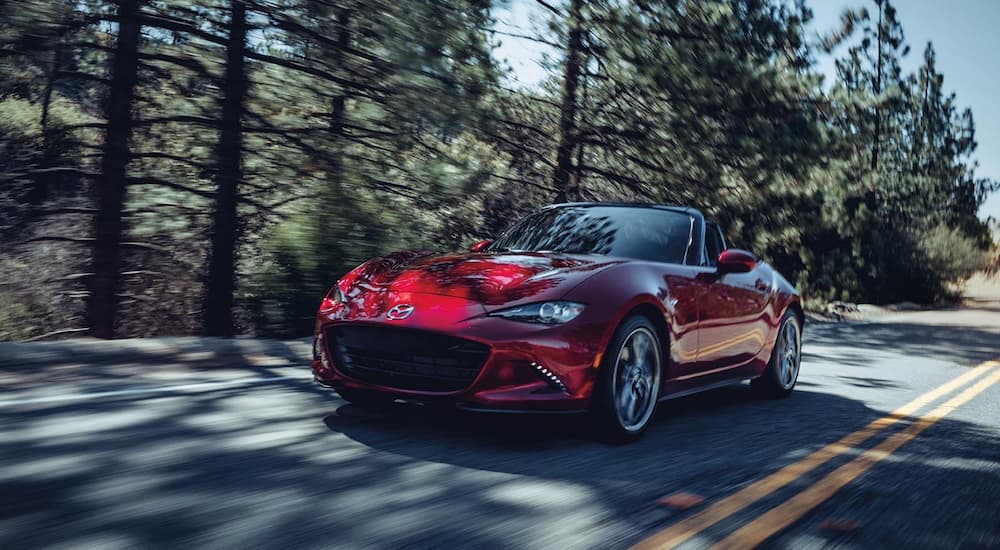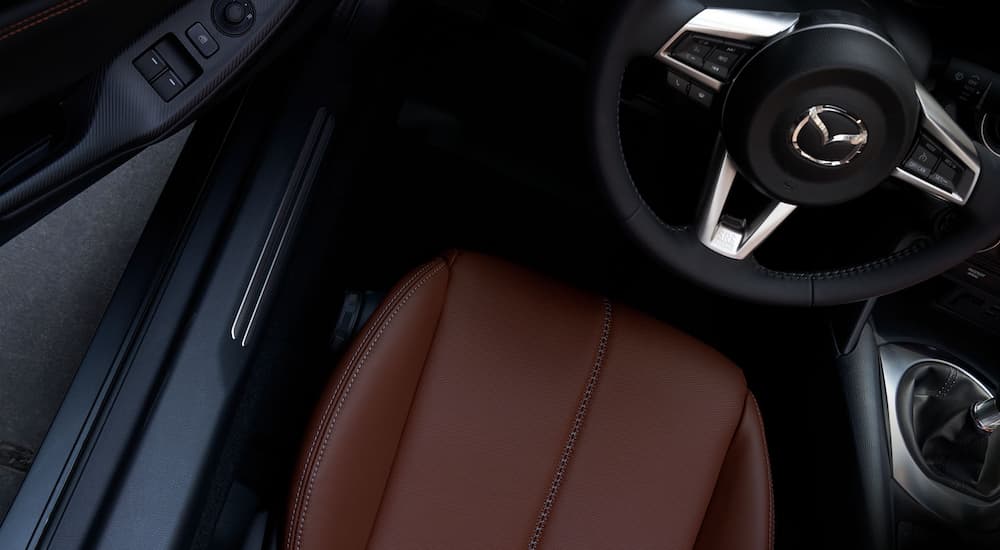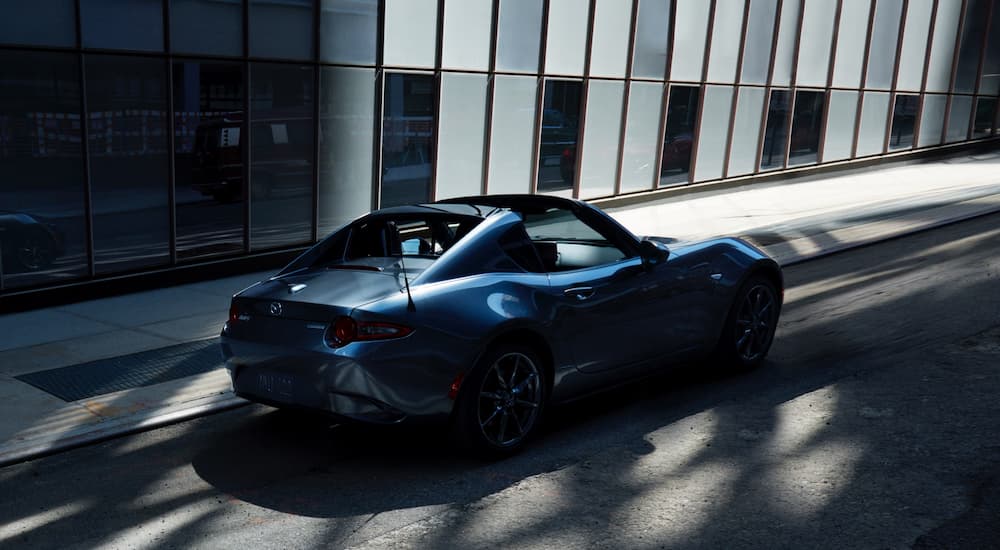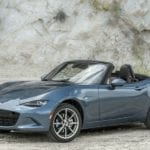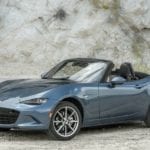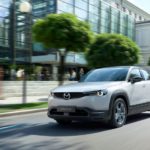Are you a sports car enthusiast with an adventurous streak? The list of high-quality, authentic sports coupes on the extinct lists at your local car dealerships is rapidly increasing. Unless you have six figures to spend on an Italian import, you could end up driving a crossover like 99% of your fellow Canadian drivers. Don’t settle for a ute when you can still own a 2022 Mazda MX-5 Miata.
Challenge even your grumpiest friend not to smile at the site of Mazda’s little convertible. It embodies driving joy with its diminutive stature and throwback exterior architecture. What it also does is provide a surprisingly athletic driving experience, thanks to Mazda’s new Kinematic Posture Control (KPC) system. “Kine, what,” you might be asking? Unfortunately, understanding it means taking a trip back to high school physics class.
You might remember learning about kinetic energy. Kinematics is all about how an object moves. Mazda has harnessed this study of motion to fine-tune the MX-5 Miata’s behaviour when performing turns. The goal is to deliver a driving experience that’s more driver-centric than driver-assisted. Combined with Mazda’s proven Skyactiv Technology and a little interior magic called KODO Design, this newest Miata gives us even more reasons to smile.
What Is Kinematic Posture Control?
Unless you’re a physicist, you’ll need a quick primer in kinetics to fully understand how Kinematic Posture Control (KPC) works. Kinetic energy plays an important role in overall vehicle dynamics. The faster the vehicle travels, the more energy it gains. KPC works to channel kinetic energy during cornering to avoid the mass of the vehicle working against it. When the system activates, drivers will feel less lift and more grip when cornering. KPC helps the vehicle maintain optimal aerodynamics and suppress body roll in a cornering maneuver.
The system is specifically designed for rear-wheel drive vehicles like the MX-5 Miata. In action, it applies gentle braking to the inner wheel, which draws the vehicle down and minimizes slipping or skidding. How is KPC activated? Most torque vectoring systems need input from the driver to activate, but Mazda’s KPC system senses speed differences in the rear wheels as the vehicle turns into a corner and gives the driver a small assist–a max of 45 psi of braking pressure.
Why is this system not seen on other sports cars? Most sports cars favour a stiffer suspension, sacrificing ride comfort for performance, but Mazda elected to maintain the Miata’s slightly softer suspension to keep its “Sunday drive” cruising spirit. KPC helps drivers corner technically. Its lightweight design adds minimal bulk, unlike more sophisticated anti-roll systems found on much more expensive sports performance vehicles.
It’s the best of both worlds, according to Dave Coleman, Mazda North America vehicle dynamics engineer. He points to uneven pavement and ruts as hindrances to ride comfort. Since the Miata’s suspension remains less stiff, the KPC system offers a more controlled and comfortable riding experience. This tech helps suppress body roll during tight cornering, so your wheels will stay firmly planted on the pavement, even at high speeds.
What Is KODO Design?
Mazda’s KODO design philosophy draws from three Japanese words that roughly translate into three core design pillars: pure and refined presence, dynamic motion, and sensuality of motion. Shortened, the term is simply KODO: Soul of Motion. It’s a design-first ethos that drives (no pun intended) the look and feel of every Mazda vehicle. With KODO, Mazda looks to capture the sinew of an animal in motion.
Sharp grilles and headlights represent the eyes, and the carved, athletic exterior lines seen on every Mazda vehicle depict a powerful, muscular animal set to pounce. The KODO philosophy takes it a step further by elevating engineers to artisans and encouraging product development practices that include infusing each vehicle with soul. Lofty though it may sound, the plan is working. Mazda’s lineup receives plenty of kudos for its KODO.
The concept was first introduced in 2010 alongside the CX-5’s debut. Borne from the SHINARI concept vehicle, KODO captures the essence of a powerful animal in a split second before it flexes and accelerates suddenly. The MINAGI concept followed, then the TAKERI, the KOERU, and a handful of others in subsequent years, each more sculpted and angular than the previous concept. The most recent, the VISION COUPE, represents the next generation of KODO design.
The VISION COUPE introduced elegance and refinement to the athletic theme. One glance at the VISION COUPE suggests a vehicle that doesn’t like sitting at the curb. Instead, this concept car is its most beautiful when in motion, which is exactly what KODO seeks to achieve. Most automotive experts agree that the KODO philosophy is behind Mazda’s incredible transformation from mass-produced ordinariness to styling standout.
Why the MX-5 Miata Is the Ideal Sports Coupe
The Mazda CX-5 is the best-selling Mazda model in Canada, but the MX-5 Miata still owns Canadians’ hearts. The Globe and Mail called it “the unofficial car of summer” after Miata sales doubled post-pandemic. They recommend the RF, or Retractable Fastback, over the traditional soft top to better weather Canada’s, well, weather, citing the small 50-kilogram increase in overall weight as a worthy sacrifice.
The MX-5 Miata evokes a visceral emotional reaction from traditionalists and forward thinkers alike. Vehicles that thrill aficionados and draw masses of buyers are unicorns, especially when they come in the form of a roadster. Canadians are obsessed with crossovers and sport utility vehicles, leaving little room for unique cars like the Miata to continue drawing buyers. Still, somehow it has done exactly that.
As a timeless roadster, the Miata joins the ranks of the Alfa Romeo Spider, the Triumph Stag, and the Fiat 124. Gleefully tiny, these classic two-door convertibles evoke leisurely weekend drives through the countryside, hair protected with a colourful head scarf and notes of lively jazz music blending with the sound of the wind. Should the Miata disappear in the coming years, it will undoubtedly join the list of roadsters that defined a generation. From the unique exterior paint to the modern RF top, this little dynamo has left its mark already. The good news is, Mazda remains committed.
The Modern MX-5 Miata
In a recent MotorTrend article, Mazda’s head of European product development, Joachim Kunz, called the Miata “our brand icon” and boldly stated, “we will have this car forever.” Given the march toward electrification, what will that mean for future Miata generations? The Miata is slated for a redesign in the 2024 model year. As of now, Mazda has no plans to electrify it. Instead, it’ll still have a gas-powered engine.
Other journalists report a different plan. Many suggest the next-gen MX-5 Miata will feature a mild-hybrid powerplant by way of Mazda’s Skyactiv-X engine technology. The Skyactiv-X engine isn’t available in North America yet, but while it’s pending certification, Mazda Canada is busy releasing news stories about its potential. It is indeed the first-ever compression-ignition technology, which means it will be more efficient and more powerful.
The 30-year-old Miata has maintained its core exterior design throughout multiple redesigns. It has also remained a relatively affordable option. At 6.6 L/100 km highway, it’s remarkably fuel efficient, which shouldn’t be a surprise given its size. The company has been thoughtful about every aspect of the Miata MX-5, and it shows. From the Kinematic Posture Control to improve ride quality to a KODO design that is attention-grabbing, there is a lot to love about the 2022 Miata MX-5.
